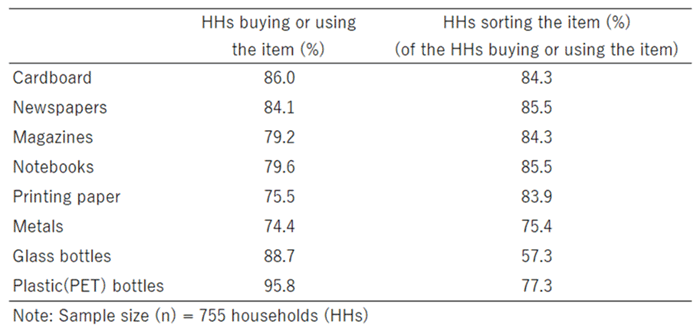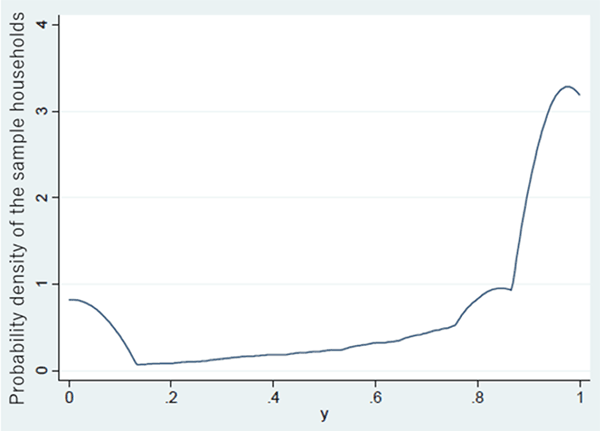- Waste management in Japan
- Circular economy in Japan
- Waste management in Asia
- Disaster waste management
Do People in Hanoi, Vietnam Recycle at Home?
Junk-buyers collect recyclable materials in many developing countries
Do people in developing countries recycle at home? This article attempts to provide an answer to this question based on the results of a survey that we conducted in the central part of Hanoi City, Vietnam.1
Before starting, it should be noted that few municipalities in developing countries offer collection services for recyclables, unlike Japan or other developed countries. In most of our survey area, the central part of Hanoi, the residents are not obliged to dispose of waste separately, except some areas that implement a program of separate collection of food waste for composting (see the October 2015 issue [in Japanese]). The residents are allowed to discharge all types of waste together, at least under the present rules (Photo 1). If you observe this situation, you might hypothesize that in the surveyed area, few households separate recyclable materials at home (at source). However, previous studies have revealed that, in developing countries, informal waste collectors, or "junk buyers," (Photo 2) actively collect recyclable materials (for details, see the article "Reality of Collecting Recyclable Materials in Vietnam" in the February 21, 2011 issue [in Japanese]). This situation implies that someone provides recyclable waste to junk buyers, from which you could make another hypothesis that it is households that separate and store recyclable materials at home for that purpose. Since these two opposing hypotheses seemed to be both valid, we decided to conduct the survey to find out how many households actually separate recyclable waste at home, and to analyze the results quantitatively.


In Hanoi, 77% of the households recycle used PET plastic bottles
We conducted the interview survey with 755 households during the period from August to October 2013. The sample households were randomly chosen in the target area of Hanoi without using any criteria. For details on the planning and preparation of the survey, please see my article "Collecting Data through Interview Surveys" in the February 2015 issue (in Japanese). These households were asked how they normally dispose of nine recyclable materials after use: cardboard, newspapers, magazines, notebooks, printing paper, metals, glass bottles, PET bottles and other plastic bottles.
Based on their responses, first, we analyzed the percentage of households separating specific recyclable materials at home prior to disposal. Table 1 summarizes the results. It shows that 84.3% of the households buying or using cardboard separate it from the remaining waste. Some households sell the used cardboard to junk buyers while others just give it away for free. Before the survey, we predicted that about half of the households buying or using cardboard separate it prior to disposal, but to our surprise, it turned out that the percentage is much higher. In the case of paper such as newspapers, magazines, notebooks and printing paper, more than 80% of the households buying or using the material separate them from the other waste. The percentages of households separating PET plastic bottles (77.3%) and metals (75.4%) from the other waste are slightly lower than the one for paper. It means that as many as three out of four households buying or using these items separately dispose of them, although these percentages may look rather low. However, only 57.3% of the households are separating glass bottles.

Households bipolarized into separators and non-separators
Next, we conducted an analysis of the number of recyclables that each household separately dispose of. For this purpose, an index y is created as below.

The y-value is between zero and one inclusive. For example, if a household buys or uses eight of the nine surveyed materials, the denominator is 8. If the household separately dispose of four out of the eight materials, the numerator is 4 and the y-value is 0.5. The y-value is therefore the ratio of the number of recyclable materials separately dispose of to the number of recyclable materials bought or being used at home.
Nine of the surveyed households responded that they do not buy or use any of the nine materials we mentioned. While it is possible that none of these nine households discharges recyclable materials, it is also possible that these households did not understand the purpose of the survey. Since these extreme responses can be found to a greater or lesser extent in any household survey, it is always important to specify their proportion. In our survey, 9 out of 755 were extreme responses, which was only a small portion. We calculated the index y with the responses from the remaining 746 households. The results suggest that there are two distinct household groups.
The histogram below (Fig.1) displays bimodal distribution of y-value. One peak on the right end indicates that many households separate almost all recyclables (with the y-value over 0.75) when they dispose of the materials that they bought or used. We call this household group "separators." In contrast, another peak on the left end (with the y-value below 0.2) suggests that another household group disposes of all the waste in a mixed state and does not recycle any material. We call this group "non-separators." Not many households fall in the middle (with the y-value around 0.5) of these two groups, meaning that not many of them dispose of half the recyclables separately and the rest half in a mixed state. In short, the surveyed households in Hanoi are roughly divided into two groups, separators and non-separators.

Summary and future work
The survey results revealed that about 80% of the households in the central part of Hanoi separately dispose of recyclable materials, and that these households recycle many types of materials. It was also found that the households are roughly divided into two distinctive groups: those that separately dispose of most recyclables ("separators") and those that do not separate recyclables at all ("non-separators").
What policy implications do these survey results have for the development of recycling programs for Hanoi City? Currently, many households in Hanoi already separately dispose of recyclable materials voluntarily even without the government's request. This situation suggests that even if the government starts any new recycling program in the future, it would not be so effective in reducing the amount of household waste. However, household waste could be reduced more effectively if these "non-separator" households start separating recyclables. Appealing to such non-separator households appeared to be the key to the successful implementation of such programs. In order to prompt such behavioral changes of households, we need to examine the following points: characteristics of non-separator households, factors that differentiate separator and non-separator households, and mechanisms to determine such behavioral differences. Our future task is to analyze further the data collected in the survey so that we can answer these questions quantitatively.
References
- Yokoo, H., Kawai K., Higuchi Y. (2018) Informal recycling and social preferences: Evidence from household survey data in Vietnam. Resource and Energy Economics, 54, 109-124


